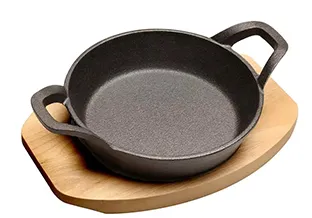
wok vs cast iron
Wok vs. Cast Iron Choosing the Right Cookware for Your Kitchen
Cooking enthusiasts often find themselves in a dilemma when choosing between different types of cookware. Two popular options that frequently come up in discussions are the wok and cast iron skillet. While both have their unique advantages, they serve varying culinary needs and styles. This article will explore the features, benefits, and uses of each, helping you to determine which cookware is the best fit for your kitchen.
Understanding the Wok
Originating from China, the wok is a shallow, round-bottomed cooking vessel that is renowned for its versatility and efficiency. The design of the wok facilitates quick and high-temperature cooking techniques, such as stir-frying, steaming, and deep-frying. Made typically from carbon steel or cast iron, woks excel in distributing heat evenly, which is crucial for achieving the characteristic taste and texture in many Asian dishes.
One of the primary advantages of the wok is its high sides, which allow for tossing and stirring ingredients without spilling. The unique shape also means that a small amount of food can be cooked effectively, making it perfect for quick meals. Additionally, woks can be seasoned to develop a natural non-stick surface, enhancing the flavor of the food while reducing the need for excessive oil.
The Benefits of Cast Iron
On the other hand, cast iron skillets are a staple in many kitchens around the world. Known for their incredible heat retention and durability, cast iron pans are great for a variety of cooking methods including frying, baking, and even braising. A cast iron skillet provides a perfect sear and is ideal for recipes that require consistent, even heat.
One of the standout features of cast iron is its ability to go from stovetop to oven seamlessly, making it a versatile tool for preparing a wide array of dishes. Moreover, cast iron cookware is excellent for slow cooking, allowing flavors to develop fully over time. It's worth noting that, like woks, cast iron skillets require seasoning to maintain their non-stick properties and to prevent rust.
wok vs cast iron

Comparative Uses
When considering which cookware to use, much depends on the type of dishes you wish to prepare. If you enjoy cooking Asian cuisine or recipes that involve rapid cooking at high heat, a wok is invaluable. The curved bottom and high sides allow for techniques like stir-frying, where ingredients are moved quickly to ensure even cooking without burning.
Conversely, if you often cook foods that benefit from even heat distribution, such as cornbread, frittatas, or pan-seared steaks, a cast iron skillet may be more appropriate. Its sturdiness makes it perfect for recipes that require a transfer to the oven or for slow-cooked dishes that develop rich flavors.
Maintenance and Care
Both woks and cast iron skillets require proper care to ensure longevity. Woks need thorough cleaning without soap, as it can remove the seasoned layer. Regularly applying oil to maintain the seasoning is also essential. Cast iron skillets also benefit from similar treatment, requiring handwashing and oiling to prevent rust and maintain their seasoned surface.
Conclusion
Ultimately, the choice between a wok and cast iron skillet boils down to your cooking style and preferences. If you are drawn to quick, high-heat cooking and Asian recipes, a wok is likely the better option. Conversely, if you enjoy a wide variety of cooking techniques and need durability, a cast iron skillet is your best bet. Both can be excellent additions to your kitchen, providing depth to your culinary adventures while enhancing your cooking experience.
-
High Quality Kitchen Durable Black Round Cast Iron Cookware Pancake Crepe Pan-Baixiang County Zhongda Machinery Manufacturing Co., Ltd.|Durability,Non-Stick SurfaceNewsJul.22,2025
-
High Quality Cast Iron Cookware-Pan with Wooden Handle|Durable,Non-Stick,Even Heat DistributionNewsJul.21,2025
-
Cast Iron Pancake Crepe Pan-Durable Kitchenware|Non-Stick&Wooden HandleNewsJul.21,2025
-
Cast Iron Pancake Crepe Pan-Durable Kitchenware|Non-Stick&Wooden HandleNewsJul.21,2025
-
Cast Iron Pancake Crepe Pan-Durable Kitchenware|Non-Stick&Wooden HandleNewsJul.21,2025
-
Cast Iron Pancake Crepe Pan-Durable Kitchenware|Non-Stick&Wooden HandleNewsJul.21,2025


